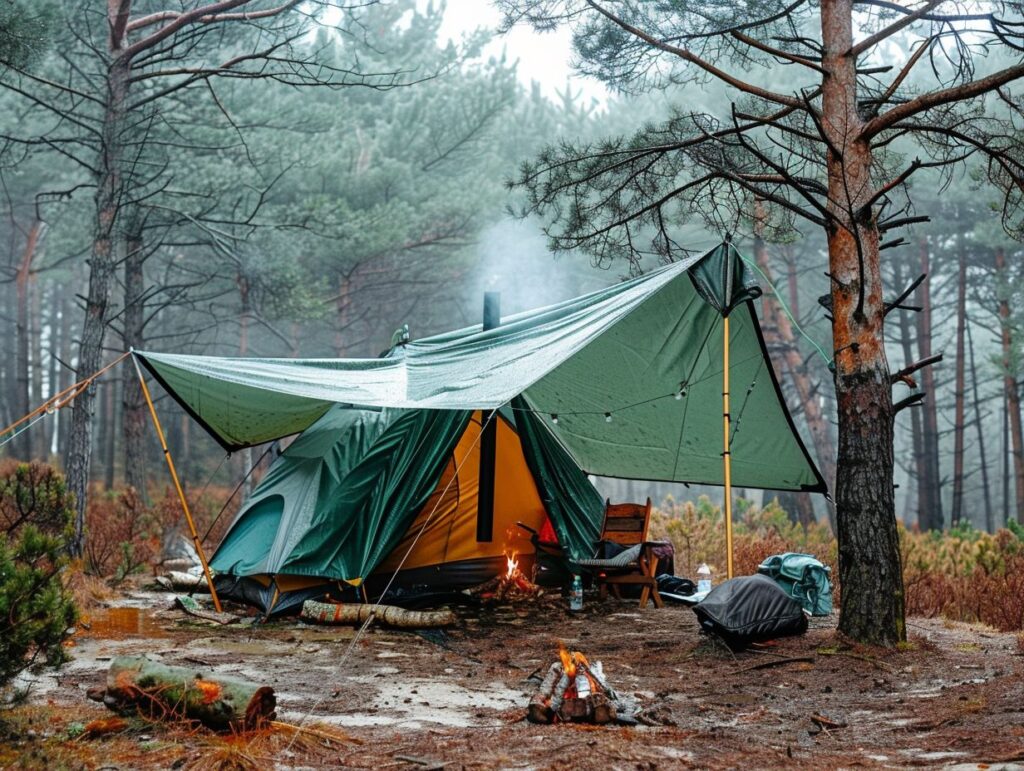Camping is a wonderful way to connect with nature and create lasting memories.
However, unpredictable weather can quickly turn a camping trip into a soggy and uncomfortable experience.
Creating a rainproof campsite is crucial to ensure a safe and enjoyable outdoor adventure.
In this article, we will discuss the essential items needed for a rainproof campsite, how to choose the best location, tips for setting up a rainproof campsite, dos and don’ts, and how to stay safe and comfortable in rainy conditions.
Let’s dive in!
Key Takeaways:
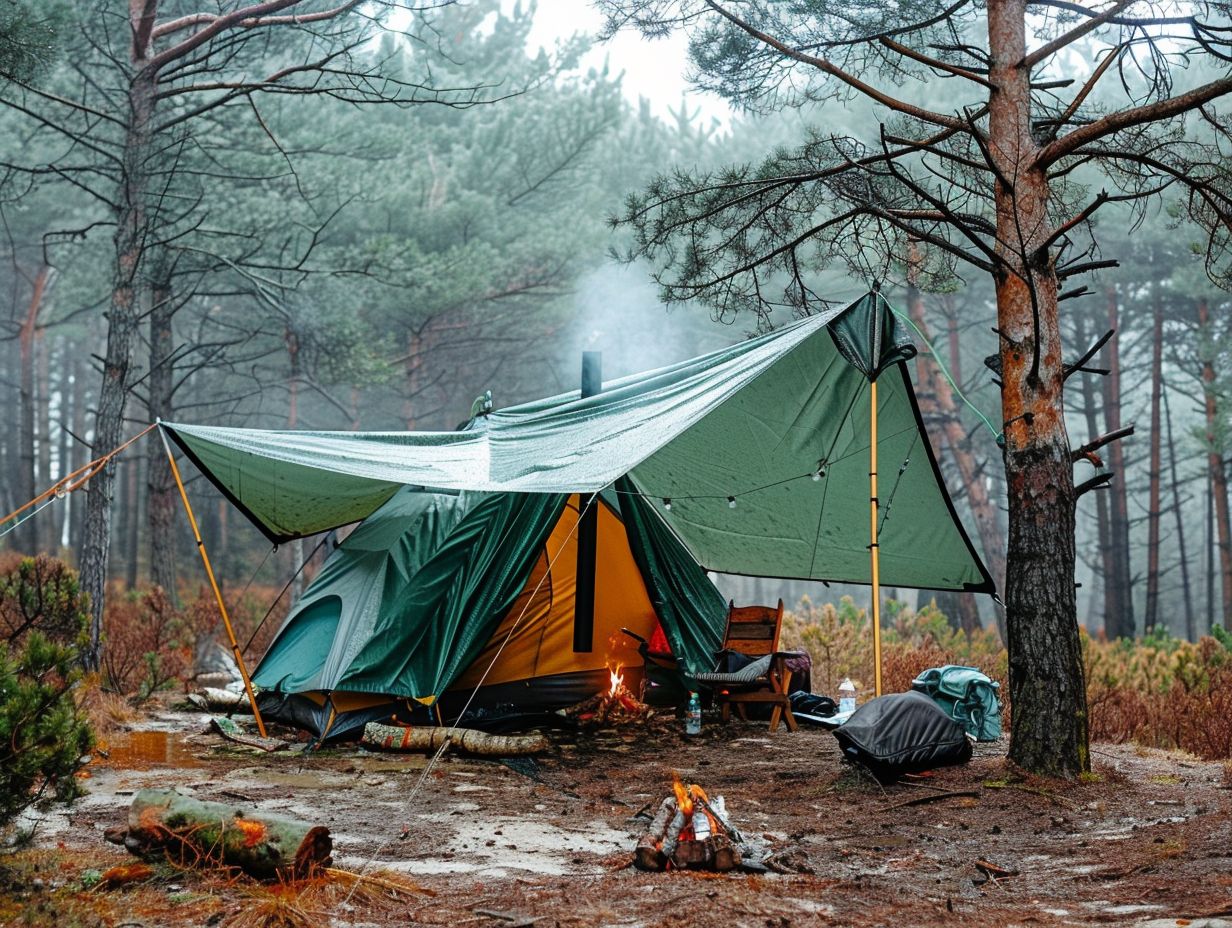
- Choose a high and sheltered location for your campsite to avoid flooding and strong winds.
- Invest in waterproof gear and set up a proper drainage system to keep yourself and your belongings dry.
- Stay safe and comfortable by staying dry, warm, and alert for potential hazards during your camping trip.
Why is it Important to Create a Rainproof Campsite?
Establishing a rain-resistant campsite is essential for any camping trip, especially in areas known for unpredictable weather patterns such as the White Mountains or Olympic National Park. This practice ensures the preservation of dryness in both equipment and sleeping quarters, thus avoiding discomfort and reducing potential health risks associated with prolonged exposure to damp environments.
What are the Essential Items for a Rainproof Campsite?
For the maintenance of a dry campsite during inclement weather conditions, it is imperative to acquire high-quality camping equipment, including a waterproof tent, a resilient tarp or rainfly, a groundsheet, and reliable rain gear.
1. Waterproof Tent
The cornerstone of a waterproof campsite is a high-quality waterproof tent, guaranteeing dryness even during heavy downpours.
When selecting a waterproof tent for outdoor activities, it is crucial to consider features such as taped seams, a sturdy flysheet, and a bathtub-style groundsheet to prevent water infiltration. Michael Lanza, a respected outdoor enthusiast, advises choosing a tent with a high hydrostatic head rating to ensure exceptional water resistance.
Ventilation plays a vital role in preventing condensation buildup inside the tent. Look for tents equipped with mesh panels and multiple vents to ensure proper air circulation. These characteristics will enhance the camping experience by maintaining comfort and dryness regardless of the weather conditions.
2. Tarp or Rainfly
The utilisation of a tarp or rainfly is deemed essential to provide an additional layer of waterproof protection, particularly in regions with high precipitation occurrences such as Glacier Bay.
Through strategic positioning of the tarp, a more effective shield against adverse weather conditions can be established.
A deliberate slanting of the tarp towards a lower point facilitates the seamless runoff of rainwater, thereby preventing any accumulation or leakage. This relatively simple modification can significantly enhance the tarp’s efficacy in maintaining dryness and comfort amidst heavy rainfall.
The adjustment of the tarp’s angle also serves to optimise airflow, consequently mitigating condensation levels within the shelter. These minor alterations can yield substantial benefits to one’s outdoor experience, ensuring an environment of dryness and comfort in the face of inclement weather conditions.
3. Groundsheet
A groundsheet plays a crucial role in maintaining the dryness of the tent floor and safeguarding equipment from moisture ingress. Various groundsheet variants cater to diverse camping requirements, accommodating a spectrum of preferences. Some models prioritise lightweight and compact designs, appealing to backpackers seeking to optimise space and minimise load.
Conversely, heavier and sturdier options are available, catering to extended camping expeditions or challenging terrains. Irrespective of the chosen variant, a groundsheet acts as a protective barrier between the tent base and the ground, thwarting the ingress of moisture.
This function not only preserves the dryness of the sleeping compartment but also enhances the longevity of the tent by mitigating damage inflicted by wear and tear. It is advisable to invest in a high-quality groundsheet to ensure a comfortable and moisture-free camping experience.
4. Rainproof Clothing and Gear
Ensuring one’s comfort and safety during a camping trip necessitates investing in high-quality rainproof clothing and gear, as emphasised by Michael Lanza. Michael Lanza emphasises the significance of possessing specific rain gear essentials to effectively combat unpredicted wet weather while camping.
An essential item is a reliable waterproof jacket with sealed seams and an adjustable hood, offering protection against rain showers. Additionally, waterproof hiking boots not only keep one’s feet dry but also provide stability on slippery terrains.
Including quick-drying attire made from moisture-wicking fabrics in your packing list ensures warmth and comfort, even in damp conditions. Furthermore, it is sensible to carry a compact and durable umbrella, easily portable in a rucksack, for additional protection during light showers.
How to Choose the Best Location for a Rainproof Campsite?
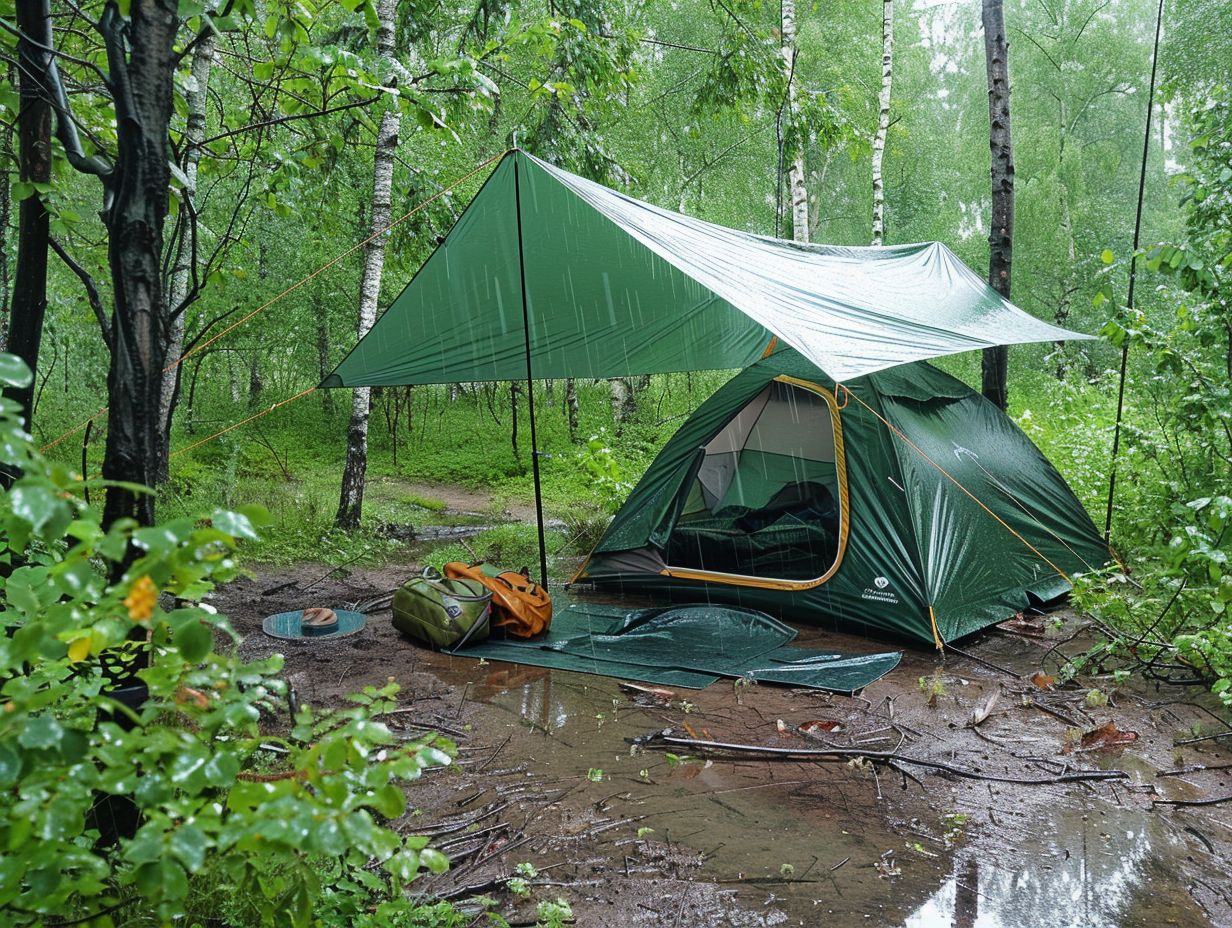
Selecting the optimal location for a waterproof campsite requires a comprehensive understanding of the terrain and meticulous preparation of the site to ensure the protection of your tent and equipment from dampness.
1. Avoid Low-Lying Areas
It is imperative to avoid low-lying areas when selecting a location to pitch your tent to prevent water accumulation and ensure dryness in the event of rainfall. Low-lying areas present several hazards during camping, including an increased risk of flooding, water pooling, and heightened vulnerability to extreme weather conditions.
To identify these areas, it is advisable to observe indicators such as standing water, damp soil, or depressions in the ground. When choosing a camping spot, it is recommended to go for elevated terrain or locations with effective drainage to mitigate the potential for water-related challenges.
Careful consideration of the surrounding topography is essential, and it is advisable to avoid pitching a tent near water sources such as rivers, streams, or valleys where water flow may occur during heavy precipitation.
2. Look for Natural Shelter
The utilisation of natural shelters such as trees and rock formations can serve as an effective means of enhancing protection from rain, as emphasised by outdoor specialist Michael Lanza.
Strategically incorporating the innate features of the landscape can substantially improve the waterproof capability of your campsite. Trees offer not only shelter from direct precipitation but also aid in mitigating the impact of strong winds.
Placing your tent in close proximity to a dense grouping of trees can lessen the effects of heavy rainfall. Additionally, rocky outcrops can function as a barrier against rain, providing a protective barrier between your campsite and the elements.
Selecting a campsite location that capitalises on these natural attributes can enhance the comfort and enjoyment of your outdoor experience, even when encountering inclement weather conditions.
3. Consider Wind Direction
When selecting a campsite, it is essential to consider wind direction in order to properly position your tent and tarp for optimal rain protection, particularly in windy environments like Grand Teton. To accurately assess wind direction, there are several methods that can be employed.
One method involves observing natural indicators in the vicinity, such as the movement of leaves, smoke, or water waves if near a body of water. Alternatively, tools like windsocks or attaching a small piece of string to the tent can aid in determining wind flow.
After determining the direction of the wind, it is advisable to position the tent so that the narrow end faces into the wind to reduce resistance. Additionally, aligning the tarp perpendicularly to the wind can offer further rain protection and enhance stability.
How to Set Up a Rainproof Campsite?
Establishing a waterproof campsite involves correctly pitching a tent, using a tarp or rainfly, and putting in place an efficient drainage system to control water flow.
1. Set up the tent correctly
Ensuring the proper setup of a tent is paramount in maintaining its waterproof integrity and providing adequate shelter. To correctly pitch a tent, begin by locating a flat and level area for its placement.
Clear away any objects, such as rocks, sticks, or debris, that may pose a risk of puncturing the tent floor. Position the tent body and orient it based on the direction of the prevailing wind to optimise ventilation.
Assemble the tent poles, ensuring their correct insertion into the corresponding eyelets or sleeves. When erecting the tent, ensure the angles are taut and securely fastened to prevent sagging or collapse. Fine-tune the tension on the guy ropes to stabilise the structure, making any necessary adjustments for a snug and secure fit.
Emphasizing these aspects will result in the creation of a robust and weather-resistant shelter.
2. Use a Tarp or Rainfly
Utilising a tarp or rainfly can significantly enhance the waterproof capabilities of a campsite, as advised by Michael Lanza.
To correctly install a tarp or rainfly, the process should begin by anchoring one side to a tree or post at an appropriate elevation. Subsequently, extend the opposite end and adjust it to create a slight incline for efficient rainwater drainage.
Use paracord to secure the corners firmly, ensuring the absence of any loose ends susceptible to wind-induced flapping. It is vital to assess the tautness of the tarp or rainfly to prevent sagging or fluttering in blustery conditions. A properly erected tarp can provide shelter and protection against the elements, thereby enhancing the overall camping experience.
3. Create a Proper Drainage System
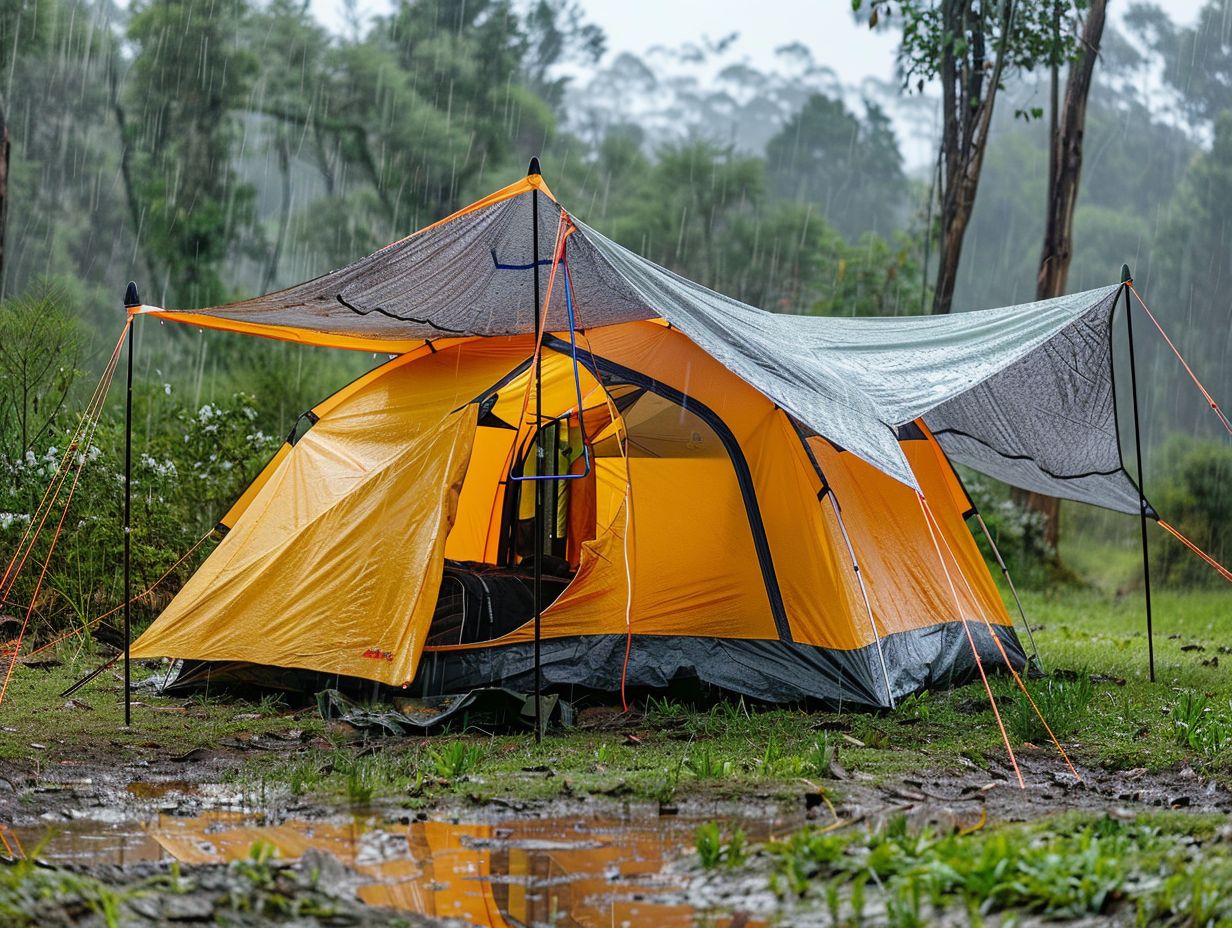
Establishing a suitable drainage system around the campsite is essential for maintaining the dryness of the tent and equipment. One critical element in developing an efficient drainage system is the strategic placement of a groundsheet. This impermeable layer between the ground and the tent serves to prevent the infiltration of moisture.
When setting up the drainage system, it is crucial to take into account the natural slope of the terrain to facilitate proper water drainage. By situating the tent at a higher altitude and constructing channels or trenches to divert water, one can effectively control any potential flooding or pooling that may arise during periods of rainfall.
What are the Dos and Don’ts of a Rainproof Campsite?
Having a thorough understanding of the necessary steps for establishing a waterproof campsite can greatly enhance your camping experience, guaranteeing that you are adequately equipped and at ease regardless of the prevailing weather conditions.
1. Do: Bring Extra Tarps or Rainflies
It is advisable to bring additional tarps or rainflies when preparing for unexpected weather fluctuations as a means of enhancing protection for the campsite.
These supplementary coverings serve to offer increased shelter against rain, wind, or intense sunlight, thereby enabling a more comfortable outdoor experience. Moreover, they have the capacity to facilitate the creation of versatile outdoor living spaces, such as covered cooking zones or shaded relaxation areas.
When utilising tarps or rainflies, it is essential to ensure their secure anchoring to prevent flapping in the wind and potential damage. Thoughtful placement can aid in diverting rainwater away from the camping vicinity, thereby maintaining dry and mud-free ground conditions.
Proactive utilisation of these materials enables campers to effectively adapt to diverse weather circumstances and optimise their camping endeavours.
2. Don’t: Leave Valuables Unprotected
Failure to protect valuables can result in damage and loss, particularly in damp environments, thus it is imperative to ensure that your equipment is stored appropriately.
To effectively safeguard your valuables from moisture and potential harm, it is imperative to invest in high-quality waterproof containers or bags.
It is advisable to select robust options that are specifically engineered to resist moisture and offer a dependable shield against water infiltration. Additionally, consider utilising vacuum-sealed bags or dry sacks to provide an extra layer of protection for your items.
Incorporating essentials such as a towel or cloth to eliminate excess moisture before storing your valuables can further aid in preventing water seepage. By implementing these preventive measures, you can rest assured that your valuables are well-protected and secure regardless of the prevailing weather conditions.
3. Do: Check the Weather Forecast
Ahead of and during a camping trip, it is essential to check the weather forecast, as recommended by Michael Lanza. Understanding the current weather conditions allows individuals to choose appropriate clothing, equipment, and supplies needed to ensure safety and comfort while taking part in outdoor activities.
Accurate weather forecasts are crucial in identifying potential dangers like severe storms, strong winds, or sudden floods, enabling individuals to adjust their plans accordingly.
Depending on reliable sources of weather information such as the National Weather Service, weather apps, and local meteorologists is essential for obtaining up-to-date and precise data to support well-considered choices during the camping trip.
How to Stay Safe and Comfortable in a Rainproof Campsite?
Ensuring a pleasant and secure camping experience in a rainproof campsite requires maintaining dryness, preserving warmth, and remaining vigilant of potential hazards. This approach allows for safety and comfort to be maintained throughout the camping expedition.
1. Stay Dry
Maintaining dryness is of utmost importance when in a waterproof campsite, and this can be achieved through the utilisation of appropriate rain gear and a well-positioned groundsheet, as recommended by Michael Lanza.
Regarding the selection of rain gear, the choice of high-quality waterproof jackets, trousers, and footwear can significantly aid in keeping dry when encountering inclement weather conditions.
Additionally, positioning the tent on elevated ground or ensuring proper drainage surrounding the campsite can effectively thwart water infiltration into the sleeping area.
Furthermore, the use of tarpaulins and the establishment of a sheltered cooking space can provide essential protection in rainy circumstances. The adoption of these measures not only enhances comfort but also contributes to a more enjoyable outdoor experience.
2. Keep Warm
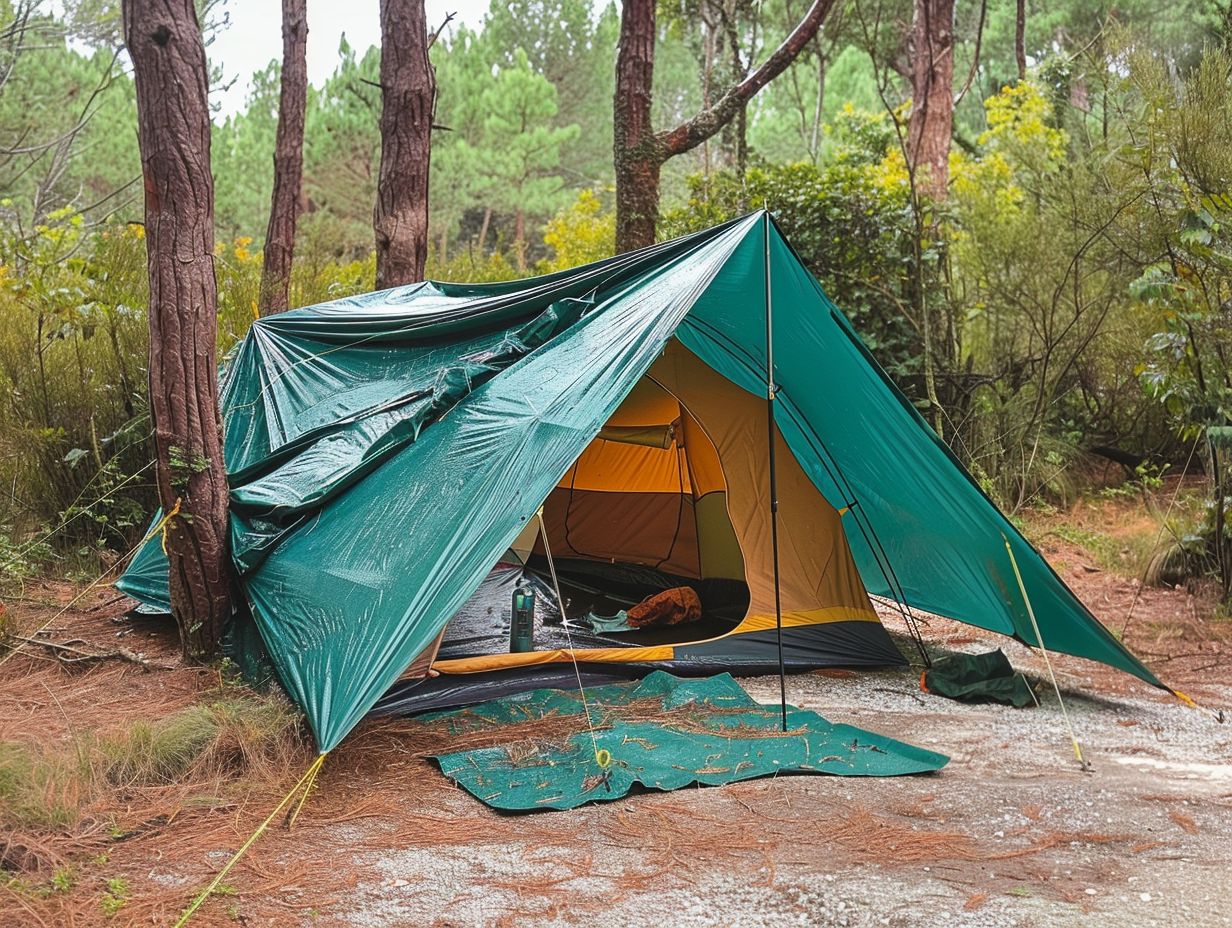
Ensuring adequate warmth in damp conditions is crucial, and establishing a secure fire or utilising a hammock can effectively preserve body heat whilst remaining dry.
The safe construction of a fire commences with the selection of an appropriate location, ensuring its segregation from any low-hanging branches or dry vegetation. The utilization of rocks to delineate a perimeter for the fire is recommended, coupled with the maintenance of a readily accessible water source for emergency purposes.
In the case of utilising a hammock, the selection of one with commendable insulation properties to trap body heat is advised. The circulation of air beneath a hammock can additionally prevent heat loss to the ground. Consequently, a hammock presents a cozy and dry alternative to resting on moist ground during chilly, humid nights in outdoor environments.
3. Stay Alert for Potential Hazards
Watchfulness towards potential hazards, such as falling branches or flooded areas, is essential for ensuring safety throughout the duration of your camping trip.
One method that proves effective in heightening landscape awareness is familiarising oneself with the terrain prior to establishing a campsite. It is advisable to make note of any steep inclines, rocky terrain, or water bodies that may present a hazard.
Furthermore, it is wise to keep easily accessible emergency supplies such as a first aid kit, torch, and additional provisions of food and water to address unforeseen circumstances. Regular monitoring of weather forecasts and adherence to any issued warnings or advisories are crucial practices for proactive risk management.
By maintaining a state of watchfulness and preparedness, one can participate in a camping experience characterised by safety and enhanced enjoyment.
Frequently Asked Questions
How can I protect my campsite from heavy rain?
A1: One of the best ways to create a rainproof campsite is by using a rain fly or tarp over your tent. This will provide an extra layer of protection and keep the rain from getting inside your tent.
What are some items I should bring to create a rainproof campsite?
A2: Some essential items to bring for a rainproof campsite include a waterproof tent, a rain fly or tarp, extra tarps for additional coverage, and waterproof bags or containers for storing your gear.
How can I ensure proper drainage at my campsite?
A3: Look for a campsite with good natural drainage, such as a slight slope or a location on higher ground. You can also dig small trenches around your site to help redirect any excess water away from your tent.
What should I do if my tent gets wet during a rainstorm?
A4: If your tent gets wet, try to dry it out as much as possible before packing it up. You can use a towel or cloth to wipe down any excess water, and then leave it out to air dry. Alternatively, you can use a portable fan or heater to speed up the drying process.
How can I protect my belongings from getting wet at a rainproof campsite?
A5: It’s important to keep all of your belongings inside your tent and off the ground to prevent them from getting wet. You can also use waterproof bags or containers to store your gear and keep them dry.
What should I do if there is a chance of rain during my camping trip?
A6: It’s always a good idea to be prepared for rain during a camping trip. Check the weather forecast beforehand and make sure to pack essential rainproof gear, such as a rain fly or tarp. It’s also a good idea to set up your campsite on higher ground or in a location with good natural drainage.

